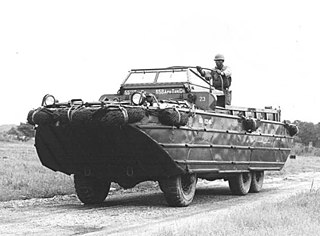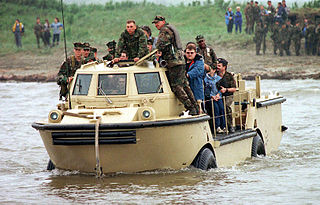
An amphibious vehicle is a vehicle that is a means of transport viable on land as well as on or under water. Amphibious vehicles include amphibious bicycles, ATVs, cars, buses, trucks, railway vehicles, combat vehicles and hovercraft.

Landing craft are small and medium seagoing watercraft, such as boats and barges, used to convey a landing force from the sea to the shore during an amphibious assault. The term excludes landing ships, which are larger. Production of landing craft peaked during World War II, with a significant number of different designs produced in large quantities by the United Kingdom and United States.
Barc or BARC may refer to:

The Amphibious Vehicle, Tracked (LVT) is an amphibious warfare vehicle and amphibious landing craft, introduced by the United States Navy and United States Marine Corps. The United States Army, Canadian Army and British Army used several LVT models during World War II, and referred to those vehicles as "Landing Vehicle, Tracked."

The DUKW is a six-wheel-drive amphibious modification of the 2+1⁄2-ton CCKW trucks used by the U.S. military during World War II and the Korean War.

A surface effect ship (SES) or sidewall hovercraft is a watercraft that has both an air cushion, like a hovercraft, and twin hulls, like a catamaran. When the air cushion is in use, a small portion of the twin hulls remains in the water. When the air cushion is turned off ("off-cushion" or "hull borne"), the full weight of the vessel is supported by the buoyancy of the twin hulls.

The landing craft mechanized (LCM) is a landing craft designed for carrying vehicles. They came to prominence during the Second World War when they were used to land troops or tanks during Allied amphibious assaults.

USS Tuscaloosa (LST-1187) was the ninth of the Newport-class tank landing ships of the United States Navy, which replaced the traditional bow door-design tank landing ships (LSTs). The vessel was constructed by the National Steel and Shipbuilding Company in San Diego, California and was launched in 1969 and commissioned in 1970 and the second ship of the United States Navy to be named after the city of Tuscaloosa, Alabama. The LST participated in the Vietnam War and was decommissioned in 1994. The ship was laid up until being sunk as a target ship during a sinking exercise in 2014.

LARC-V, is an aluminium-hulled amphibious cargo vehicle capable of transporting 5 tons. It was developed in the United States during the 1950s, and is used in a variety of auxiliary roles to this day.

LARC-XV, introduced in 1960, is an aluminium hulled amphibious cargo vehicle. It measures 45 by 15 feet and is powered by 2-300 hp engines.

USS Peoria (LST-1183) was a Newport-class tank landing ship which replaced the traditional bow door-design tank landing ships (LSTs). The vessel took part in the Vietnam War and Gulf War. The ship was constructed by the National Steel and Shipbuilding Company in San Diego, California and was launched in 1968 and commissioned in 1970. Named for a city in Illinois, Peoria was assigned to the United States Pacific Fleet and home ported at San Diego. The tank landing ship alternated between military exercises along the United States west coast and deployments to the western Pacific. Peoria took part in the evacuations of Phnom Penh, Cambodia and Saigon, South Vietnam, both of which signaled the end of American involvement in the respective countries. The vessel was decommissioned 1994 and sunk as a target ship during a RIMPAC naval exercise in 2004.

USS La Moure County (LST-1194) was the sixteenth of twenty Newport-class tank landing ship of the United States Navy (USN) which replaced the traditional bow door-design tank landing ships (LSTs). The second vessel named after a county in North Dakota, the LST was constructed by National Steel and Shipbuilding Company of San Diego, California. The vessel was launched and was commissioned into the USN in 1971. La Moure County alternated deployments in the Caribbean Sea with those to the Mediterranean Sea. During the Gulf War, La Moure County transported elements of the 4th Marine Expeditionary Brigade to the Persian Gulf. In 2000, the LST was taking part in a training exercise off Chile when the vessel ran aground. Considered beyond repair, La Moure County was decommissioned that year and towed out to sea in 2001 and sunk as a target ship.

USS Boulder (LST-1190) was the twelfth of twenty Newport-class tank landing ships of the United States Navy (USN) which replaced the traditional bow door-design tank landing ships (LSTs). Named after the county in Colorado, the ship was constructed by National Steel and Shipbuilding Company of San Diego, California. The LST was launched in 1970 and was commissioned in 1971. Boulder was assigned to the United States Atlantic Fleet and deployed in the Caribbean and Mediterranean Seas. In 1980, the ship was transferred to the Naval Reserve Force. In 1988, Boulder ran aground off Norway during a military exercise. The vessel was decommissioned in 1994 and laid up at the Naval Inactive Ship Maintenance Facility in Philadelphia, Pennsylvania. The ship was struck from the Naval Vessel Register in 2008 and towed to Brownsville, Texas for scrapping in 2022.

USS Manitowoc (LST-1180) was the second ship of the Newport-class tank landing ships which replaced the traditional bow door-design tank landing ships (LSTs) in service with the United States Navy. Manitowoc was constructed by the Philadelphia Naval Shipyard in Philadelphia, Pennsylvania and launched in 1969 and entered service in 1970.

USS Fresno (LST-1182) was the fourth tank landing ship (LST) of the Newport class. Fresno was named for a county in California. The vessel was constructed by the National Steel and Shipbuilding Company in San Diego, California and launched in 1968. The ship entered service in 1969 and was assigned to the United States Pacific Fleet, taking part in training along the west coast and operational cruises to the western Pacific, taking part in the Vietnam War. Fresno was decommissioned in 1993 and laid up. The LST was nearly sold to Peru but remained in the U.S. inventory until 2014, when Fresno was sunk as a target ship in the Pacific Ocean during a training exercise off Guam.

USS Bristol County (LST-1198) was the last of the twenty Newport-class tank landing ships of the United States Navy (USN) which replaced the traditional bow door-design tank landing ships (LSTs). The LST was constructed by National Steel and Shipbuilding Company of San Diego, California. Bristol County was launched in 1971 and commissioned into the USN in 1972. Bristol County was assigned to the United States Pacific Fleet and remained in service until 1994 when it was decommissioned. Sold to Morocco that year, the vessel was recommissioned into the Royal Moroccan Navy as Sidi Mohammed Ben Abdellah. The ship remains in service.

The PTS is a Soviet tracked amphibious transport. PTS stands for Plavayushchij Transportyer - Sryednyj or medium amphibious transport vehicle. Its industrial index was Ob'yekt 65.

An amphibious warfare ship is an amphibious vehicle warship employed to land and support ground forces, such as marines, on enemy territory during an amphibious assault.

The Engin de débarquement amphibie rapide (EDA-R) is a class of French roll-on/roll-off catamaran landing craft (L-CAT) operated by the French and Egyptian navies. They transport vehicles, cargo and personnel from Mistral-class amphibious assault ships to shore.

The LACV-30 was a hovercraft used by the U.S. Army Mobility Equipment Research and Development Command (MERADCOM) for offloading cargo from amphibious ships. For logistic transport, the Army was already using the LARC-V and LARC-LX, huge 4-wheeled vehicles referred to as 'barges on wheels'. The Army used the LACV-30 to transport 20 ft. standard MILVAN containers as well as outsize loads that would not fit on a LARC-V or LARC-LX. MERADCOM operated 24 LACV-30s between 1983 and 1994.

























